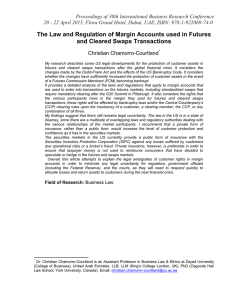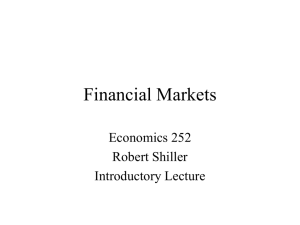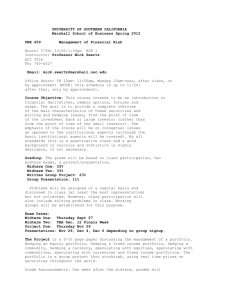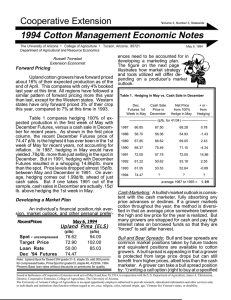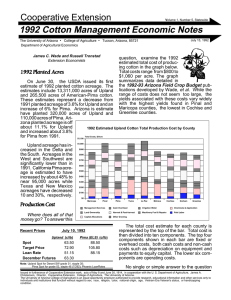Chapter 13
advertisement
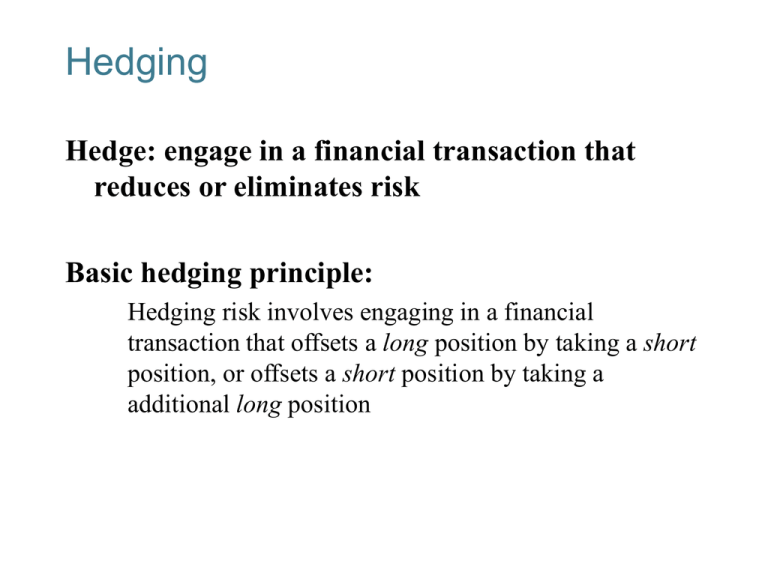
Hedging Hedge: engage in a financial transaction that reduces or eliminates risk Basic hedging principle: Hedging risk involves engaging in a financial transaction that offsets a long position by taking a short position, or offsets a short position by taking a additional long position 13-1 Interest-Rate Forward Markets Long position = agree to buy securities at future date Hedges by locking in future interest rate if funds coming in future Short position = agree to sell securities at future date Hedges by reducing price risk from change in interest rates if holding bonds Pros 1. Flexible Cons 1. Lack of liquidity: hard to find counterparty 2. Subject to default risk: requires information to screen good from bad risk 13-2 Financial Futures Markets Financial Futures Contract 1. Specifies delivery of type of security at future date 2. Arbitrage at expiration date, price of contract = price of the underlying asset delivered 3. i , long contract has loss, short contract has profit 4. Hedging similar to forwards Micro (individual securities) vs. macro hedge (entire portfolio) Traded on Exchanges: Global competition Regulated by Commodity Futures Trading Commission Success of Futures Over Forwards 1. Futures more liquid: standardized, can be traded again, delivery of range of securities 2. Delivery of range of securities prevents corner (somebody buys out certain type of security) 3. Mark to market and margin requirements: avoids default risk 4. Don’t have to deliver: netting 13-3 Widely Traded Financial Futures Contracts 13-4 Widely Traded Financial Futures Contracts 13-5 Hedging FX Risk Example: Customer due 10 million euro in two months, current rate: 1 euro = $1 1. Forward contract to sell 10 million euros for $10 million, two months in future 2. Sell 10 million of euro futures 13-6 Options Options Contract Right to buy (call option) or sell (put option) instrument at exercise (strike) price up until expiration date (American) or on expiration date (European) Hedging with Options Buy same # of put option contracts as would sell of futures Disadvantage: pay premium Advantage: protected if i , gain if i Additional advantage if macro hedge: avoids accounting problems, no losses on option when i 13-7 Profits and Losses: Options vs. Futures $100,000 T-bond contract, 1. Exercise price of 115, $115,000. 2. Premium = $2,000 13-8 Factors Affecting Premium 1. Higher strike price lower premium on call options and higher premium on put options 2. Greater term to expiration higher premiums for both call and put options 3. Greater price volatility of underlying instrument higher premiums for both call and put options 13-9 Interest-Rate Swap Contract 1. Notional principle of $1 million 2. Term of 10 years 3. Midwest SB swaps 7% payment for T-bill + 1% from Friendly Finance Co. 13-10 Hedging with Interest-Rate Swaps Reduce interest-rate risk for both parties 1. Midwest converts $1m of fixed rate assets to rate-sensitive assets, Rate Sens. Assets , lowers gap (liabilities-assets) 2. Friendly Finance RSA , lowers gap Advantages of swaps 1. Reduce risk, no change in balance-sheet 2. Longer term than futures or options Disadvantages of swaps 1. Lack of liquidity 2. Subject to default risk Financial intermediaries help reduce disadvantages of swaps 13-11


